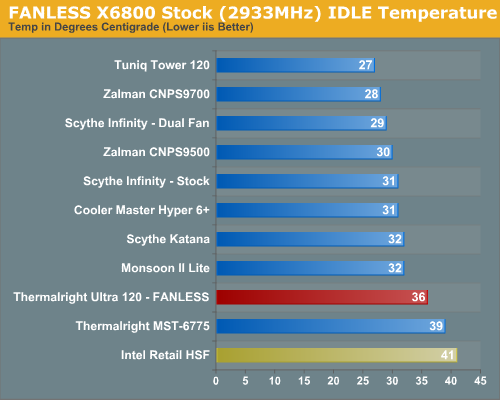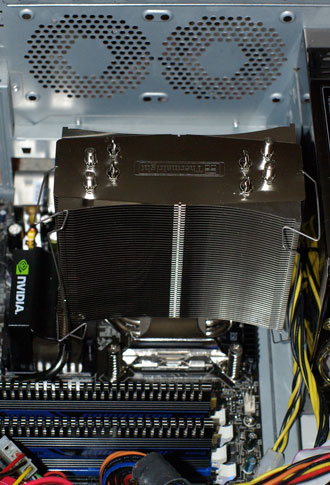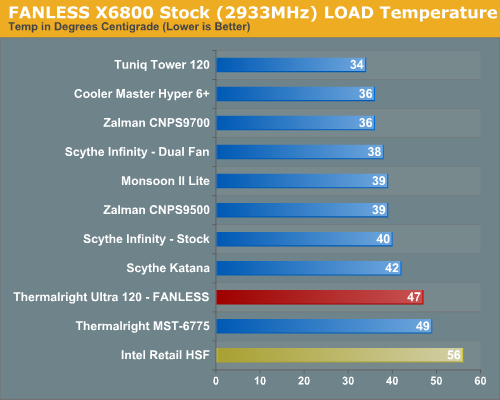Thermalright Ultra 120: Elegant, Fanless and Efficient Cooling
by Wesley Fink on March 5, 2007 12:05 AM EST- Posted in
- Cases/Cooling/PSUs
Fanless Cooling
The Ultra 120 is based on the design of the fanless HR-01, so we were interested in seeing how the Ultra 120 performed without a cooling fan.

Even without a cooling fan the Ultra 120 managed to keep the CPU cool at idle. This performance is actually a bit better than the stock Intel retail HSF which does have a fan. Where the very good Intel stock cooler keeps the X6800 at 41C at idle, the fanless Ultra 120 can manage an even better 36C, with no fan at all.

Cooling efficiency of the fanless Thermalright Ultra 120 was also compared under load conditions at stock speed by continuously looping a benchmark test of Far Cry. The Far Cry River demo is looped for 30 minutes and the CPU temperature is captured at four second intervals with the NVIDIA monitor "logging" option. The highest temperature during the stress test is then reported. Momentary spikes are ignored, as we report a sustained high-level temp that you would expect to find in this recording configuration.

The temperature after 8 minutes of heavy load testing reached 47C. During the 30 minutes of testing the Ultra 120 never exceeded 62C. It also quickly returned to 48C after the stress testing, but it took quite a while to return to the idle 36C. This demonstrates that our case setup is very poor for a fanless CPU cooler.
Our stock OCZ PowerStream 520 is a poor design for a fanless cooling system. Thermalright recommends a power supply with a down-facing fan (one that removes air from the CPU area) be used for cooling for the fanless HR-01. Many other power supplies use this design and they would definitely improve fanless performance of the Ultra 120. Therefore our fanless test results should be considered absolute worst case.
Fanless Overclocks
Fanless benchmarks were also run at two moderate overclocks. At 3.2GHz (12x267 at default voltage), temperatures started at 40C. We measured temperatures after each 8 minutes of load test and found maximum temperatures at 58C-67C-71C-82C. The system never failed even though temperatures as high as 82C were reached during testing. It is again clear our case design is not exhausting enough air for this cooler in fanless operation while it is overclocked.
Tests were also run fanless at 3.5GHz (13x277 at stock voltage). Idle at 3.5GHz fanless was 50C. 8-minute interval stress temperatures were 69-75-81-fail. We are confident that a better ventilated case and a power supply with a down facing fan above the CPU would improve air flow enough for day-in and day-out operation at moderate overclocks with a fanless Ultra 120. With no case fans, no CPU fan, and a power supply that exhausts air only to the rear there was nothing to adequately remove heat from the case/CPU. With a reasonable case/PSU setup for fanless use you will likely get performance levels close to our first set of load measurements.
It is clear from the Ultra 120 testing without a fan that this heatsink can easily cool a Core 2 Duo at stock speed without a fan. It also will likely handle moderate overclocks at stock voltages. It is important to use a power supply with a CPU down-facing fan for best fanless performance. Case exhaust fans would also help, as well as rear fan ducts such as those supplied on the Thermalright HR-01 fanless cooler.
For those whose main concern with cooling is low noise the ability to cool with no fan at all is hard to beat. Fanless CPU cooling requires careful attention to airflow in the case and the design of the power supply, but the reward is the lowest noise possible with air cooling.
The Ultra 120 is based on the design of the fanless HR-01, so we were interested in seeing how the Ultra 120 performed without a cooling fan.

Even without a cooling fan the Ultra 120 managed to keep the CPU cool at idle. This performance is actually a bit better than the stock Intel retail HSF which does have a fan. Where the very good Intel stock cooler keeps the X6800 at 41C at idle, the fanless Ultra 120 can manage an even better 36C, with no fan at all.

Cooling efficiency of the fanless Thermalright Ultra 120 was also compared under load conditions at stock speed by continuously looping a benchmark test of Far Cry. The Far Cry River demo is looped for 30 minutes and the CPU temperature is captured at four second intervals with the NVIDIA monitor "logging" option. The highest temperature during the stress test is then reported. Momentary spikes are ignored, as we report a sustained high-level temp that you would expect to find in this recording configuration.

The temperature after 8 minutes of heavy load testing reached 47C. During the 30 minutes of testing the Ultra 120 never exceeded 62C. It also quickly returned to 48C after the stress testing, but it took quite a while to return to the idle 36C. This demonstrates that our case setup is very poor for a fanless CPU cooler.
Our stock OCZ PowerStream 520 is a poor design for a fanless cooling system. Thermalright recommends a power supply with a down-facing fan (one that removes air from the CPU area) be used for cooling for the fanless HR-01. Many other power supplies use this design and they would definitely improve fanless performance of the Ultra 120. Therefore our fanless test results should be considered absolute worst case.
Fanless Overclocks
Fanless benchmarks were also run at two moderate overclocks. At 3.2GHz (12x267 at default voltage), temperatures started at 40C. We measured temperatures after each 8 minutes of load test and found maximum temperatures at 58C-67C-71C-82C. The system never failed even though temperatures as high as 82C were reached during testing. It is again clear our case design is not exhausting enough air for this cooler in fanless operation while it is overclocked.
Tests were also run fanless at 3.5GHz (13x277 at stock voltage). Idle at 3.5GHz fanless was 50C. 8-minute interval stress temperatures were 69-75-81-fail. We are confident that a better ventilated case and a power supply with a down facing fan above the CPU would improve air flow enough for day-in and day-out operation at moderate overclocks with a fanless Ultra 120. With no case fans, no CPU fan, and a power supply that exhausts air only to the rear there was nothing to adequately remove heat from the case/CPU. With a reasonable case/PSU setup for fanless use you will likely get performance levels close to our first set of load measurements.
It is clear from the Ultra 120 testing without a fan that this heatsink can easily cool a Core 2 Duo at stock speed without a fan. It also will likely handle moderate overclocks at stock voltages. It is important to use a power supply with a CPU down-facing fan for best fanless performance. Case exhaust fans would also help, as well as rear fan ducts such as those supplied on the Thermalright HR-01 fanless cooler.
For those whose main concern with cooling is low noise the ability to cool with no fan at all is hard to beat. Fanless CPU cooling requires careful attention to airflow in the case and the design of the power supply, but the reward is the lowest noise possible with air cooling.










30 Comments
View All Comments
Wesley Fink - Monday, March 5, 2007 - link
The Thermalright mounting holes were not designed to hold fan wires for two fans. They are about the diameter of a single wire and two just won't fit. The lower fan clip mount hole opens and breaks if you try to mount two fan wires in the mounting hole. Clearly Thermalright did not design the Ultra 120 for multiple fan mount, though we agree the design looks a natural for a push-pull fan setup. In the end the Thermalright cooled as well or better than anything, even a two-fan Infinity, using just one excellent fan.The mounting surface of the Thermalright was reasonably flat and smooth. The flatness mattered a great deal more when you were dealing with a small surface area mount like the AMD Socket A from the past. With processors today shipping with a large area heatspreader the surface flatness is less important, but it still matters.
The proper application of thermal compound matters a great deal in performance. We usually place a little larger than a BB-sixed glob of thermal in the center of the CPU and mount. When the heatsink is removed that normally has spread on mounting to the edges of the processor with no thermal grease builup around the sides of the processor. THe prurpose of thermal grease is to fill the irregularites of the mounting surfaces and improve contact between the mounting surfaces.
xsilver - Monday, March 5, 2007 - link
would it be easy for a mod job to add the ability to mount 2 fans? screwing them in to the fins directly maybe?JoKeRr - Monday, March 5, 2007 - link
Guess in the end it's not just the # of heatpipes and overall fin surface area. Great review overall. btw, what kind of thermal compound do you guys use? And I thought fluid dynamic bearing was developed by Panasonic instead of sony.Would it be possible in the future to test arctic coolings Freezer 7 Pro? That looks like a decent tower heatsink, and it comes with a fan too. Also it's much cheaper as well. It will be really nice to see how that heatsink compares to the bigger towers. Another question I have concerns with previous generation heatsinks. Currently I have a ThermalRight XP-90 with a 92mm panaflo, my cpu is a socket 478 P4 3.0ghz OCed to 3.6ghz at default v-core (it's a northwood core btw). I know XP-90 is a very good heatsink, and I'm really considering of using it on my future LGA775 setup (with a LGA775 bracket), but it's really hard to compare it with new heatsinks. Thanks again.
Wesley Fink - Monday, March 5, 2007 - link
I have referenced the review showing toothpaste and Kraft Vegemite superior to a well-known siver compound several times in past review comments. As we have stated several times, in our experience the thermal compound doen't matter. The Thermalright comes with a white soupy themermal compound in a tube, and that is what we used. As we have said before, if the cooler manufacturer cares enough to include a tube or jar of thermal grease that is what we use. If it is just a packet or no thermal grease included, we use our standard silver-colred (no silver content) tube thermal compound.In our tests of various thermal compounds in the past, we found the thermal compound made used made no difference at all. That is particularly true now that all the current CPUs use heatspreaders. On past small surface area processors like the AMD Socket A, The thinner compounds were sometimes more effective short term, but even there the thermal grease used made no difference in cooling after a few days pf seating - all else being the same.
Souka - Monday, March 5, 2007 - link
Hmm...I seem to recall a number of reviews that clearly demonstrate the differing effects of compounds on coolers....
DrMrLordX - Tuesday, March 6, 2007 - link
I believe you mean reviews like this?http://forumz.tomshardware.com/hardware/DaClan-Rev...">http://forumz.tomshardware.com/hardware...-Interfa...
Shin-Etsu x23 = winnar
goinginstyle - Monday, March 5, 2007 - link
What were the results of this fan in the Tuniq 120 and did you try it on the Scythe that was reviewed last week? It looks like a fan review is in order after seeing these results.Wesley Fink - Monday, March 5, 2007 - link
The Tuniq and Scythe are supplied with 120mm fans, and we tested the heatsinks with those fans. The Thermalright does not come with a fan, so we used the best fan we had in the lab that balanced quiet and cfm, in this case the Scythe S-Flex, for testing.With the Scythe Infinity, we also tested the 2-fan push-pull configuration using two Scythe stock fans that are like those shippied with the Infinity. These are NOT the same fan as the Scythe S-Flex. We tested this configuration because Scythe claimed the multi-fan setup was best for demanding cooling situations and the Infinity heatsink can mount up to 4 fans.
Introducing the fan as another variable in standard heatsink reviews changes the scope of these reviews. You can always replace the fan with a better one if it is removable, as we say in almost every review. Most fans can be replaced, but the Zalman coolers, for example, use non-removable embedded fans. We will take a closer look at 120mm fans in the future, but for now we will test with the fan supplied with the heatsink. This is how users will buy the heatsink.
It is likely the Tuniq fan noise at full speed could be reduced by using the Scythe S-Flex instead of the supplied Tuniq fan. However, sooling effieciency of the Tuniq and Thermalright Ultra 120 are already virtually the same, and we seriously doubt the Tuniq would coold more effectively than it already does by changing to a Scythe S-Flex fan. We did try a high-output Silverstone fan on the Infinity in that review, and it did marginally improve cooling a degree C, however a high-output fan on the Infinity doid not bring the single fan Infinity even close to the cooling performance of the Tuniq Tower 120 or the Thermalright Ultra 120. THe overclocking still topped out at 3.83GHz with a single fan on the Infinity and 3.90GHz with the dual fan push-pull.
PICBoy - Tuesday, March 6, 2007 - link
Hi Wesley. That was a GREAT review with totally unbelievable results and you have clarified things like the thermal compound influence on these reviews.Do you think the Scythe Infinity would be closer to the Tuniq 120 (like 54-55ºC) if it was mounted with the dual fan push-pull configuration usign 2 Scythe S-Flex or something stronger like 2 Scythe Minebea NMB Silent IC Series (75.9 CFM - 31.0 dBA)?
Wesley Fink - Tuesday, March 6, 2007 - link
The Scythe Infinity stock fans are considerably lower output than the Scythe S-Flex fan, but they are very quiet. I suspect two S-Flex SFF21F fans in push pull would definitely improve the cooling efficientcy of the Infinity.However you may want to wait a few days to see a review of a new cooler from Thermaltake. It will post this week and is definitely worth waiting for.